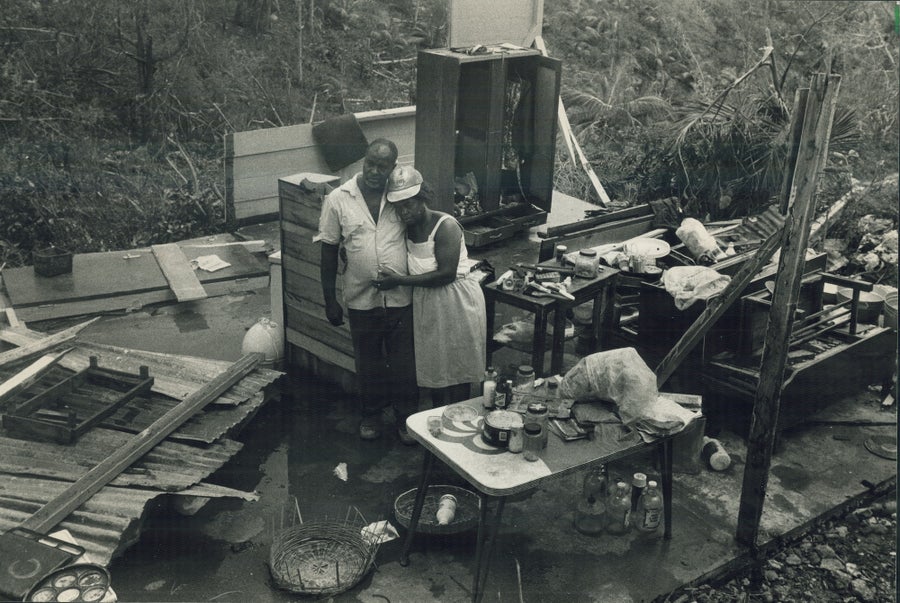October 27, 2025
3 min read
Why Hurricane Melissa Could Be the Worst Storm to Ever Hit Jamaica
Category 5 Hurricane Melissa’s exceptional strength and slow pace could make it more destructive than Hurricane Gilbert, which hit Jamaica in 1988
A cyclist rides up to a store to seek shelter from Hurricane Melissa in Portmore, Jamaica, on October 26, 2025.
Ricardo Makyn/AFP/Getty Images
As Category 5 hurricane Melissa bears down on Jamaica, it is poised to be the worst storm to ever hit the Caribbean island, surpassing the damage from Hurricane Gilbert in 1988.
Gilbert, which hit Jamaica as a Category 4 hurricane, sent 19 feet of storm surge slamming into the eastern shore of the island and brought torrential rains and destructive winds. It killed 49 people, destroyed 100,000 homes and did $700 million in damage, according to the U.S. National Oceanic and Atmospheric Administration.
Melissa, though, is far stronger and will hit from a direction that could expose more coastline to surge. And it is slower moving, which means Jamaica will be subjected to the storm’s onslaught—especially torrential rains—for longer.
On supporting science journalism
If you’re enjoying this article, consider supporting our award-winning journalism by subscribing. By purchasing a subscription you are helping to ensure the future of impactful stories about the discoveries and ideas shaping our world today.
“This is going to be a lot worse than Gilbert,” says Phil Klotzbach, a senior research scientist at Colorado State University, who studies hurricanes.
READ MORE: Hurricane Science Has a Lot of Jargon—Here’s What It All Means
Jamaica is no stranger to storms, but it has only been hit directly by five major ones (those of Category 3 or stronger), according to the best available historical records, which go back to the late 19th century. All of those major storms were either Category 3 or Category 4—we don’t know of any in recorded history that hit the island as a Category 5.
And Melissa is in rarefied company even among already rare Category 5 storms—it is exceptionally intense for an Atlantic basin hurricane. As of Tuesday morning, its maximum sustained winds are a shocking 185 miles per hour, making it one of the most intense hurricanes ever measured in the Atlantic. Gilbert’s winds topped out at 130 mph when it collided with Jamaica.

Not much was left of the home of Clarence Bryan and Mazlyn Richard in the parish of St. Thomas on Jamaica’s eastern end after Hurricane Gilbert hit in September 1988.
Photo by Colin McConnell/Toronto Star via Getty Images
Even if Melissa weakens some before it makes landfall in Jamaica, it will still be an exceptionally strong storm, and the fact that it is hitting from the south means it is running smack into a longer coastline than Gilbert did with its eastern approach. The nation’s capital, Kingston, sits on its southern shore.
The surge from Melissa is expected to reach nine to 13 feet above ground level, but exactly where that surge will be concentrated will depend on the storm’s exact path. Even small deviations could make a big difference in where the worst winds and waves hit. The farther west Melissa drifts before making a sharp turn to the northeast, the less likely it will be that the major population areas of the eastern half of the country, such as Kingston, will see the worst of the surge.
And then there is the fact that Melissa is creeping along at a pace between 3 and 5 mph, compared with Gilbert’s more typical 12 mph. “It’s barely moving,” Klotzbach says, which means the winds, surge and rain will last agonizingly long. In fact, “they’ve been getting rain from this storm for days now,” Klotzbach says, as the weather system has drifted south of the island. Most of Jamaica is projected to get more than a foot of rain, and a wide area is forecast to get up to 30 inches. Some spots could see up to 40 inches. That amount of rain can be catastrophic, especially in Jamaica’s hilly terrain, where it can cause flash floods and landslides.
The Jamaican government has ordered mandatory evacuations for some flood-prone areas, according to the Jamaica Observer, and utilities are planning ahead for restoration efforts once the storm passes. “A Category Four hurricane potentially going through the middle of our island could have unprecedented damage on our facilities,” said Hugh Grant, chief executive officer of the Jamaica Public Service Company (JPS), at a media briefing on Sunday, according to the Jamaica Observer. “Here at JPS it’s likely to be a rebuild and not just a restoration.”
Editor’s Note (10/28/25): This article was edited after posting to update Hurricane Melissa’s wind speed.
It’s Time to Stand Up for Science
If you enjoyed this article, I’d like to ask for your support. Scientific American has served as an advocate for science and industry for 180 years, and right now may be the most critical moment in that two-century history.
I’ve been a Scientific American subscriber since I was 12 years old, and it helped shape the way I look at the world. SciAm always educates and delights me, and inspires a sense of awe for our vast, beautiful universe. I hope it does that for you, too.
If you subscribe to Scientific American, you help ensure that our coverage is centered on meaningful research and discovery; that we have the resources to report on the decisions that threaten labs across the U.S.; and that we support both budding and working scientists at a time when the value of science itself too often goes unrecognized.
In return, you get essential news, captivating podcasts, brilliant infographics, can’t-miss newsletters, must-watch videos, challenging games, and the science world’s best writing and reporting. You can even gift someone a subscription.
There has never been a more important time for us to stand up and show why science matters. I hope you’ll support us in that mission.

